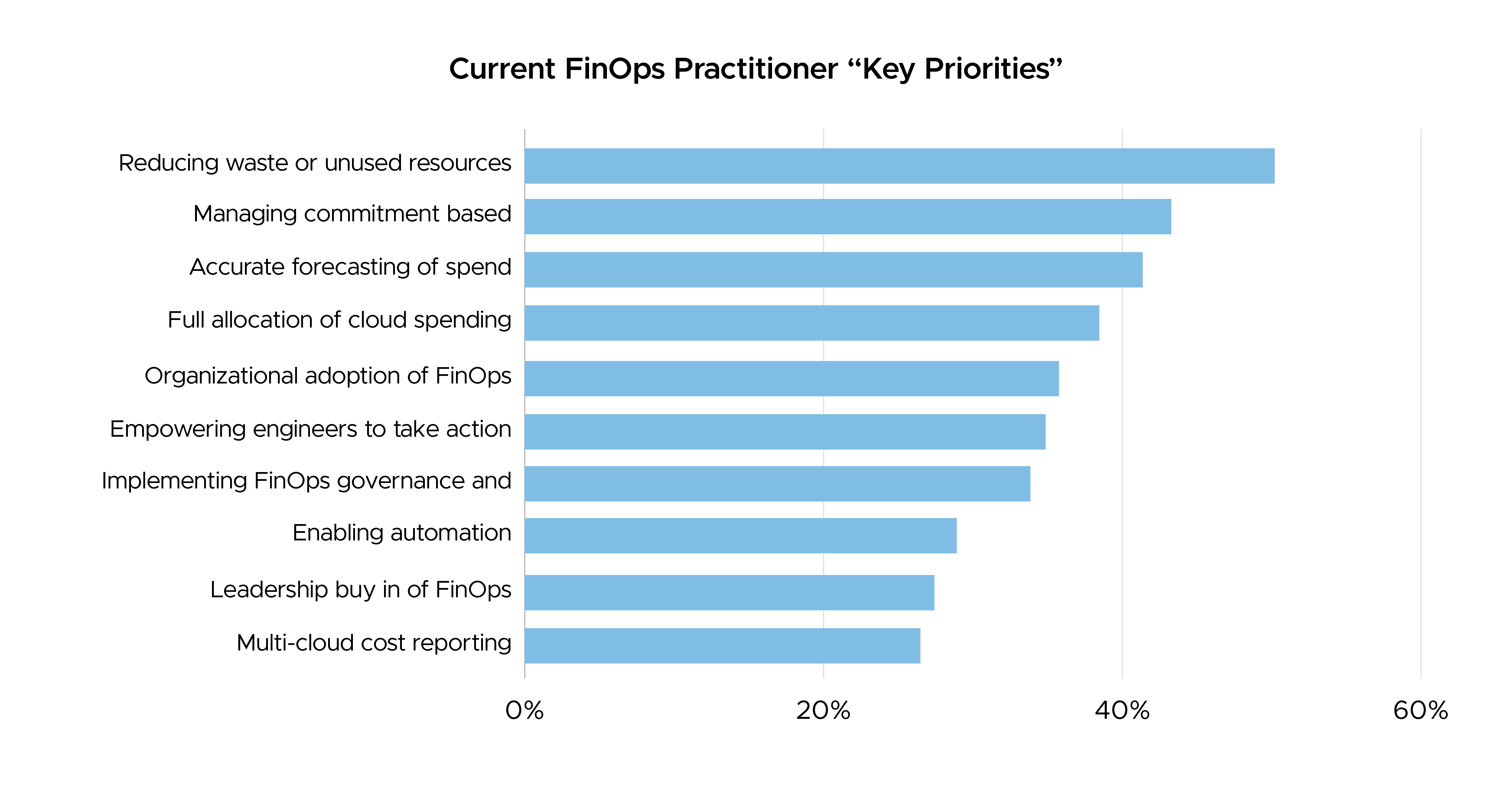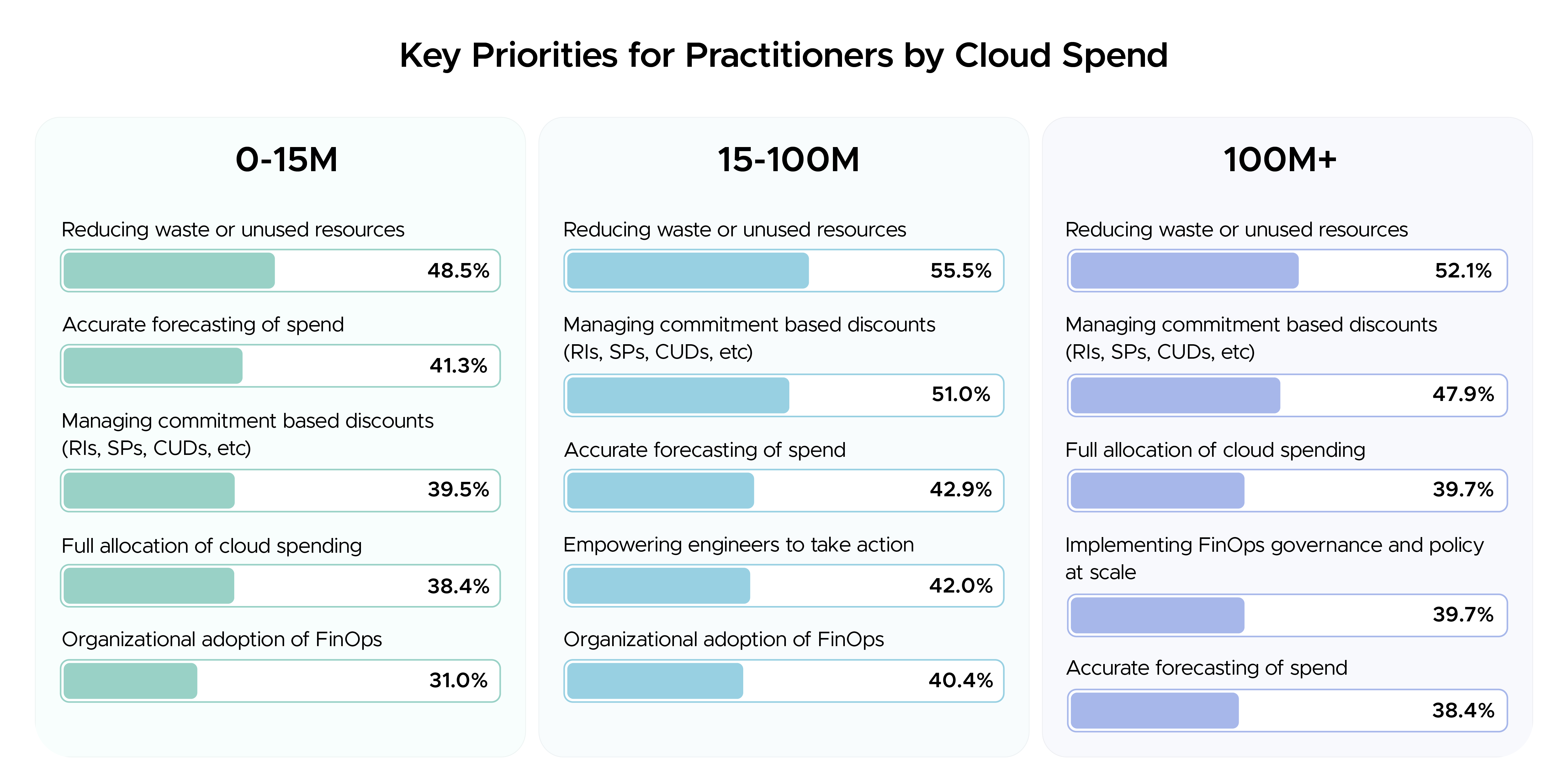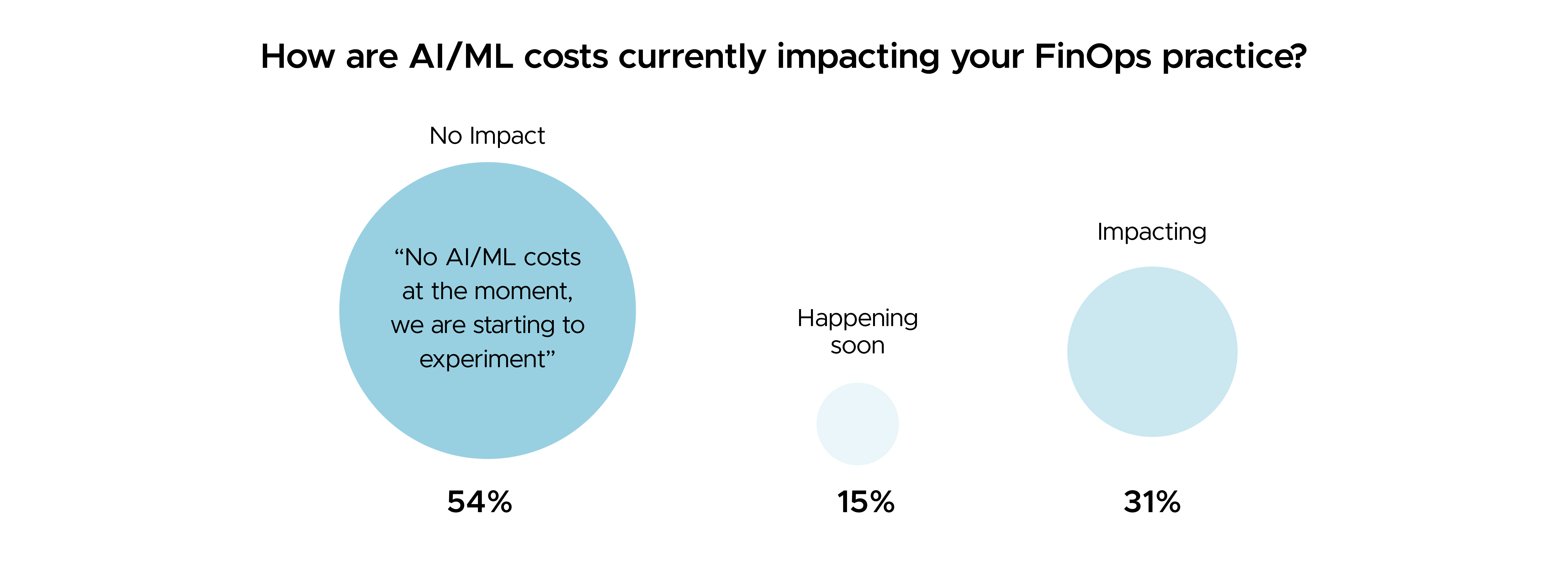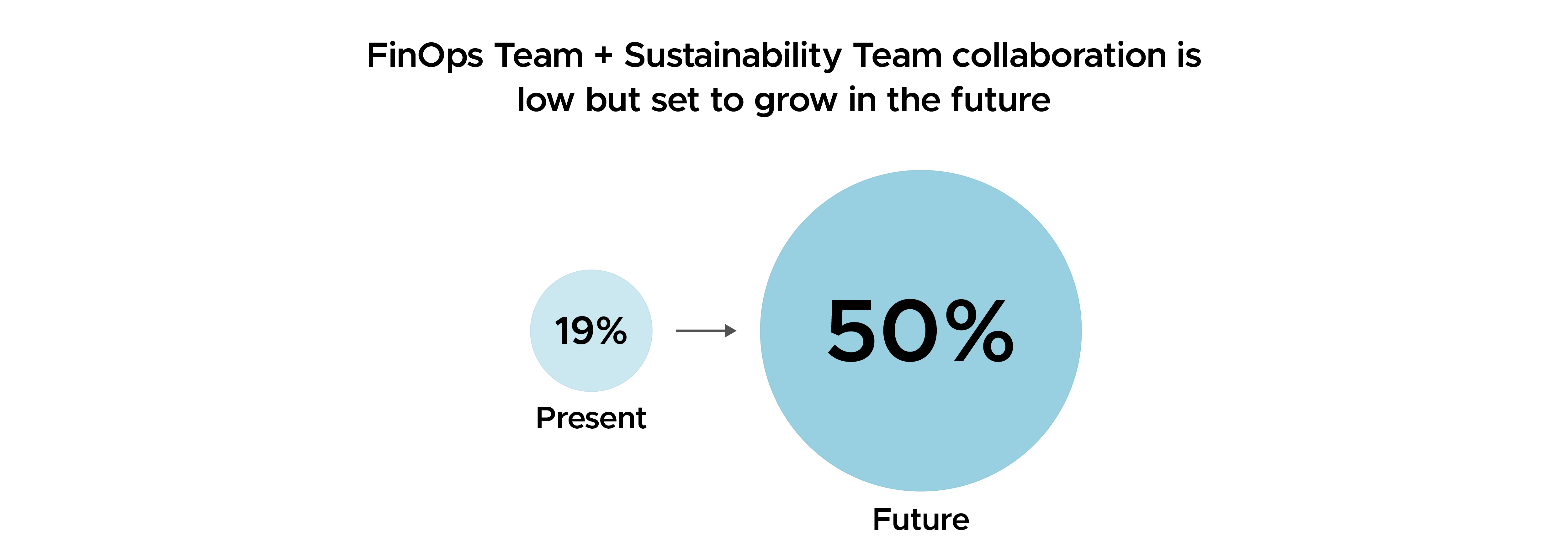The FinOps Foundation runs an annual survey titled as "State of FinOps", to understand how FinOps practices are evolving globally across organizations. The survey is open year-round with a data snapshot taken each January. This year, over 1,200 practitioners from various companies (with an average cloud spend of $44M/year) participated. The survey helps the Foundation track industry trends and inform the FinOps community on the FinOps best practices.
The State of FinOps 2024 report paints a clear picture of how FinOps is adapting to a changing technological and economic landscape. Here's a closer look at some key findings:
1. Economic Pressures Reshape Priorities: Reducing Waste & Maximizing Discounts
With tighter budgets, reducing cloud waste and maximizing discounts by managing commitment-based offerings (Reserved Instances, Savings Plans, etc.) are top priorities. This shift reflects a need to get the most value out of cloud investments.

While still important, empowering engineers is no longer the top focus. This suggests a temporary shift towards centralized control to ensure efficient resource utilization.
Minimizing Cloud Waste can free up resources, reduce overheads, and do much more than saving money. Furthermore, you can partner with a cloud FinOps expert who would help:
- Identifying unused or underutilized resources.
- Recommending the optimal commitment plans (Reserved Instances, Savings Plans) to maximize savings based on your specific usage patterns.
- Providing automated management of commitment plans, to free up your IT staff to focus on other priorities.
2. Cloud spending priorities differ based on the budget size
Lower Spenders: For organizations with lower cloud spend, accurate cloud cost forecasting is crucial to avoid unexpected cost spikes and ensure spending stays within budget. Here is an outlook revealed in the survey report.

While accurate forecasting falls at the second priority for low spenders, it stands at the fifth priority for the highest spenders.
Higher spenders: High spenders already have strong forecasting, so their priorities shift. Their top concern is managing commitment discounts (e.g., Reserved Instances) to maximize cloud cost savings from these complex plans. Proper allocation of cloud costs becomes more important for them as well, given the challenge of tracking costs across different teams and projects in large organizations (examples: Walmart, CapitalOne, etc.).
Cloud spending priorities are largely consistent across major providers (AWS, Azure, GCP) except for multi-cloud cost reporting. Google Cloud users prioritize this more than AWS or Azure users, suggesting a need for better cloud cost visibility in multi-cloud environments with Google Cloud.

CloudKeeper can help address the different priorities for various budget sizes.
For low spenders, the granular cloud cost visibility feature of CloudKeeper Lens can help businesses stay on budget and avoid surprises. Our platform can also help in improving forecasting accuracy.
For higher spenders, CloudKeeper can help in managing complex commitment plans and ensure the maximum discounts with a dedicated cloud FinOps Consulting and Support service. With a dedicated team of experts, CloudKeeper can help in allocating cloud costs across different teams and projects for better visibility and control.
3. Cloud Cost Optimization: A Focus on Compute, But Room for More
Even though cloud cost optimization is a top priority, most businesses focus heavily on optimizing compute costs (think servers) while neglecting other areas. This is likely because compute instances require heavy expenses when provisioned On Demand and also have the most readily available optimization tools.
There's significant room for improvement, especially in newer technologies like containers, serverless, and AI/ML. The good news is that the cloud FinOps community has created a library of resources to help you optimize cloud costs across different cloud providers.
4. AI/ML in cloud FinOps: A Two-Sided Coin
31% of survey respondents said that the costs of AI/ML are impacting their FinOps practice today.
Companies heavily invested in Artificial Intelligence and Machine Learning (AI/ML) are starting to see the impact on their cloud bills. The early days of AI/ML in the cloud mirror the initial cloud adoption phase. Uncontrolled experimentation led to unexpected cost spikes, forcing a shift toward cost management. This is a reminder that cloud FinOps best practices, which focus on managing and optimizing cloud spending, need to consider AI/ML expenses as well.

The FinOps Foundation recommends implementing reporting, forecasting, and basic controls for any new cloud technology.
Looking forward, it's unclear if AI/ML will become a major cost burden or an enabler of intelligent optimization for FinOps. While some experience cost challenges, others hope AI/ML will streamline cost management tasks.
5. Sustainability and Cloud FinOps - A Budding Partnership
There's growing interest in combining cloud FinOps (cloud cost management) with sustainability efforts. This is driven by:
- Availability of cloud provider sustainability data (e.g., Google Cloud, AWS, Azure).
- New government regulations requiring sustainability reporting.
Currently, less than 20% of FinOps teams collaborate with sustainability teams. However, half of the respondents expect this to change in the future. Collaboration is expected to move from information sharing to shared responsibilities.

EMEA (Europe, Middle East, Africa) leads the way in sustainability reporting, with nearly twice the collaboration between cloud FinOps and sustainability teams compared to North America.

The lack of established best practices for integrating cloud FinOps and sustainability highlights the newness of this area. Different maturity levels in sustainability reporting across cloud providers further complicate things.
CloudKeeper, a Premier Partner of the FinOps Foundation, has the competency to support businesses in establishing or improving their cloud FinOps culture. Additionally, our cloud cost visibility and recommendation platform can help identify opportunities to optimize your cloud footprint for both cost and sustainability.
6. FinOps Embraces Automation, But Humans Remain Key Players
While cloud cost optimization remains a top priority, automation is seeing a significant rise in importance, especially for smaller and medium cloud spenders. This suggests that FinOps teams are looking to automate tasks for greater efficiency.
However, the survey reveals limited use of full automation. Most teams leverage automation for data gathering and identifying areas for action, but humans still take manual steps.

There seems to be a lack of trust in fully automated actions, especially among large spenders in regulated industries. Additionally, integrating automation with existing workflows and tools can be challenging.
CloudKeeper agrees that human oversight is still crucial in cloud FinOps. We provide a Zero-touch Automated Reserved Instances Management Platform for AWS RI management which also allows for human review, control, and customization.
7. Self-Service Reporting Empowers Engineers in FinOps
The survey shows that engineers are leading the way in leveraging self-service reporting. This highlights the value of providing reports that enable real-time decision-making for all cloud FinOps personas.
Empowering employees to manage cloud costs is key to a successful cloud FinOps practice. Easy-to-understand FinOps reports (built in-house, from a 3rd party, or using cloud provider tools) should empower everyone to get their queries addressed, without relying on others. This promotes faster decision-making and greater agility.

However, the survey also reveals that sustainability and procurement teams are lagging behind in utilizing self-service reports. For sustainability teams, incomplete data might be a hurdle. Procurement teams may need more cloud and FinOps training to get the most value from these reports.
In support, CloudKeeper provides clear and actionable self-service reports that all FinOps personas, including engineers, can leverage for real-time decision-making.
8. Cloud Cost Forecasting Needs Work
Accurate cloud cost forecasting allows businesses to take advantage of cloud provider tools and resources. It also gives leadership confidence to support experimentation and innovation.
However, the State of FinOps survey reveals room for improvement in forecasting capabilities.

Many features haven't been implemented yet, likely due to a lack of sophisticated tools, and processes, or simply not being prioritized.
While manual adjustments are common (because they're easy), features like leveraging cost KPIs and automatic adjustments are desired by many.
This suggests that organizations need to invest in improving their cloud cost forecasting capabilities. This is where CloudKeeper Lens, our proprietary cloud cost visibility and recommendation platform works well in filling the gap.
Conclusion
The 2024 FinOps survey highlights how cloud FinOps practices are evolving to address current trends - economic pressures, sustainability integration, and Artificial Intelligence.
FinOps plays a crucial role in aligning cloud spending with business goals. With changing priorities and continuous cloud adoption, cloud FinOps practitioners remain essential to optimize costs and adapt to new challenges.
Working with Cloud FinOps experts like CloudKeeper will help organizations act upon all their FinOps and cloud cost optimization priorities seamlessly and get maximum ROI on their cloud investments.
CloudKeeper can be your one-stop solution for all your FinOps and cloud cost optimization needs.

CloudKeeper can help address the different priorities for various budget sizes. https://baseballbrosgame.io/online
Thanks for your useful sharing!
https://ja.leawo.com/
https://stickmanhookgame.org challenges players to master smooth, rhythmic swings by tapping at the perfect moment, maintaining momentum, and performing satisfying flips while flying through the air.